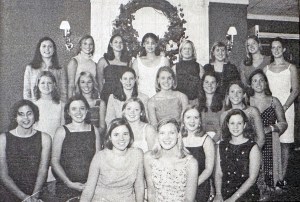The Town Crier: Recipe for happiness (part one)
Published 8:00 am Thursday, April 11, 2024

- The Town Crier
I’m kind of hungry. I’m not always hungry, but I can always eat. and with that in mind, I’m going to the old shelf in the kitchen and pull down a recipe book.
Well, what do you know? From 1982 here’s the “Crown Gardens Cuisine” fundraiser cookbook put out by the Whitfield-Murray Historical Society, whose headquarters are the Crown Gardens and Archives right next to the Crown Cotton Mill.
Trending
The Whitfield-Murray Historical Society owns and manages several historic properties including the Huff House in Dalton and the Wright Hotel in Chatsworth. The book of recipes was a fundraiser, but after 40 years I’m not sure how much money it raised or how many pounds it added to the waistlines of locals. As long as there is a copy out there (and I’ve got one!) the legacy of the ladies that contributed to the book and the organization will live on. So get your measuring cups out and your tubs of margarine and let’s get recipe-ing.
Thank you, ladies, one and all
A homey piece of artwork is on the cover, something that looks like it was from the ’70s more than from the ’80s. There’s a rocking chair with a basket of apples sitting next to it and there’s an old, wood-burning stove with a tea pot, a steaming hot pie (I’m assuming apple) and a pot of beans all simmering on it. Or maybe it’s hominy.
On the first page there is an “Expression of Appreciation” where the organization thanks all the individuals who donated recipes, compiled the book, helped with sales or in any other way (cooking and eating the recipes?) contributed to the publication of this delightful cookbook. Perhaps “delicious” cookbook would be more appropriate.
The next page has the usual copyright (1982) by Cookbook Publishers in Lenexa, Kansas. There are pages between the sections of the book illustrated by photographs, and I think they are probably stock images Cookbook Publishers provided.
At the bottom of the page, however, is a paragraph-length note on the plastic spiral binding of the book. It says this is the “finest plastic ring binder available,” a selling point no doubt in 1982. Good to know the historical society didn’t scrimp when it came to plastic ring binders. It increases my faith in the quality of the recipes contained therein.
Trending
Then it goes on to warn that the binders can be damaged (melted) by “excessive heat,” so “avoid” things like exposing it to direct sunlight, leaving it in a car on a hot day or (and this makes the most likely sense) leaving it on a hot stove. Leaving it on a hot stove would of course bring a new meaning to “cooking the recipes.” Don’t expose it to direct or excessive heat and it’s promised the binders will last “indefinitely.” I can personally attest it will last at least 41 years.
The officers at the time of publishing were House Committee Chairman Judy Alderman, Corresponding Secretary Louise Coker, Treasurer Lyle Kinney, Secretary Dot Seaton, Vice President Ellen Thompson and President Mary Gene Dykes. Thank you, ladies, one and all. If it hadn’t been for the women, how much of our history would have been lost? These ladies are leaders.
Next is the table of contents with seven sections for the discerning cook. There are “Appetizers, Pickles, Relishes” followed by “Soups, Salads, Vegetables” (mmmmmm, soups), then “Main Dishes,” then baked goods (“Breads, Rolls, Pastry”) with “Cakes, Cookies, Desserts” (mmmmm, desserts), followed by “Candy, Jelly, Preserves” and finishing with “Beverages and Miscellaneous” (mmmmm, miscellaneous).
A handy list of spices
Before we get to the first recipes, there’s a handy list of spices called for in the recipes with a little description and info on them. It starts with “allspice.”
Already I’m learning something. I thought allspice was a combination of a lot of spices, so it was “all spices,” but turns out it’s just a single spice. It comes from a fruit the size of a pea from Mexico and South America.
It does have flavors that seem to come from other spices, like cinnamon and nutmeg, but it is just the one thing.
Basil is next and this book says it’s good to flavor tomato dishes (it’s used a lot on Italian food these days) but also for turtle. Bay leaves come from an evergreen plant, and caraway is grown in the Netherlands.
Another surprise is that curry is not a single spice but a combo, the opposite of my allspice beliefs. It’s a blend of ginger, turmeric and up to 20 other spices. Used in Indian and Asian food, it can be pretty hot and spicy depending on some of those spices.
Speaking of India, that’s where dill comes from, that magic spice for us pickle lovers.
They suggest here that dill will add magic to sauerkraut (which is already pickled), potato salad, “cooked macaroni” (as opposed to uncooked macaroni?) and green apple pie. Hmmm.
This is going to sound weird, but as a kid one time we wanted a snack and someone grabbed the hamburger sliced dill pickles and someone else grabbed the Apple Jacks cereal. Eventually, one of the kids dared one of the others to eat them together. Dare accepted because as a kid you have to! Turns out they really tasted good together. I’ve told people that story over the years and they’ve pooh-poohed me, telling me that had to taste horrible.
No greater authority than the Whitfield-Murray Historical Society has vindicated me after 50 years of being mocked for my recipe. Satisfaction that comes late is still satisfaction.
Mace, which I think of as one of those war clubs knights use once they’re off the horse or as a spray used by the police on rioters, turns out to also be a spice that comes from the dried covering of the nutmeg seed. It has nutmeg qualities but is unique. It’s used in doughnuts and chocolate desserts, so if you want to “mace” me, aim for the mouth.
After marjoram (from the mint family) comes MSG, which is not a spice at all but a food additive. It’s not used like it used to be, and some people have an allergic reaction to it. It’s “monosodium glutamate” and is from a vegetable protein, used on meats and in some Asian dishes and lots of fast foods and processed foods. Read the label.
Next is oregano followed by paprika, which is a red pepper and is at the lowest end of the Scoville Heat Scale for peppers, with more flavor than heat. Plus, it will give you a dash of color sprinkled on top.
The list finishes off with poppy, used as seeds for bread; rosemary, which is like little pine needles; sage and thyme, which come from shrubs; and finally, turmeric for the big finish, a root of the ginger family, and which is supposed to be very good for you.
The recipes
We now hit the first of the recipes, including those for “ersatz rumaki,” which, considering I don’t know what actual rumaki is, the ersatz version, broiled, bacon-wrapped water chestnuts, can’t let me down.
“Mrs. Duffy’s Hors D’oeuvres” are explained in detail but Mrs. Duffy is left a mystery.
The recipe is submitted by Mary McKnight, so maybe the Duffys are friends of hers. I hope they’re friends.
There’s a recipe for “pecan cheese wafers,” which sounds pretty good, and a recipe for “scramble,” that we call “Chex mix,” made from the Chex line of cereals. This is the savory version and you can make a sweet version that I’m curious to see if this book includes. The “scramble” recipe was submitted by Polly Boggess, who was a key figure in both the historical society and local theater productions including at Dalton High.
Next is “Soups, Salads, Vegetables.” I bet when you heard “salads” you didn’t immediately think of a gelatin salad. Well, Mary Gene Dykes did! She submitted three gelatin-based salads: “The Apricot — Orange Gelatin Delight,” the “Lemon — Light Fruit Gelatin” (I bet it’s a delight as well) and the “Pineapple — Grapefruit Salad.” They are all citrusy, and they are, if you’re a kid stuck at a potluck, fun to eat.
A few more recipes that caught my eye were for “Aspic for 30” which is a tomato gelatin dish; a “Ten Layer Salad,” which is a bit of a stretch since they count a sprinkle of sugar as a layer (Is it a layer? Yes. Is it a LAYER? No!) and there’s a “Festive Carrot Ring.” I’m for anything festive. It’s “mashed carrots” instead of mashed potatoes that you then cook with the other ingredients in a ring mold. Once done, you fill the hole in the middle with peas. Rabbits love it and it’s good for your eyes.
Next time we will learn proper kitchen measurements and work our way through the main dishes toward my personal goal of desserts.
Mark Hannah, a Dalton native, works in video and film production.




